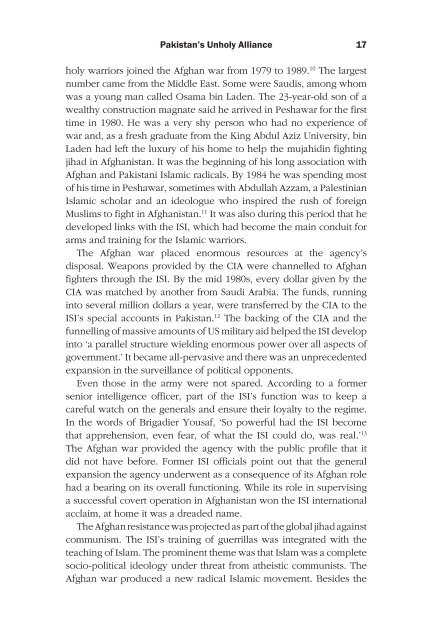Frontline Pakistan : The Struggle With Militant Islam - Arz-e-Pak
Frontline Pakistan : The Struggle With Militant Islam - Arz-e-Pak
Frontline Pakistan : The Struggle With Militant Islam - Arz-e-Pak
You also want an ePaper? Increase the reach of your titles
YUMPU automatically turns print PDFs into web optimized ePapers that Google loves.
<strong><strong>Pak</strong>istan</strong>’s Unholy Alliance<br />
holy warriors joined the Afghan war from 1979 to 1989. 10 <strong>The</strong> largest<br />
number came from the Middle East. Some were Saudis, among whom<br />
was a young man called Osama bin Laden. <strong>The</strong> 23-year-old son of a<br />
wealthy construction magnate said he arrived in Peshawar for the first<br />
time in 1980. He was a very shy person who had no experience of<br />
war and, as a fresh graduate from the King Abdul Aziz University, bin<br />
Laden had left the luxury of his home to help the mujahidin fighting<br />
jihad in Afghanistan. It was the beginning of his long association with<br />
Afghan and <strong><strong>Pak</strong>istan</strong>i <strong>Islam</strong>ic radicals. By 1984 he was spending most<br />
of his time in Peshawar, sometimes with Abdullah Azzam, a Palestinian<br />
<strong>Islam</strong>ic scholar and an ideologue who inspired the rush of foreign<br />
Muslims to fight in Afghanistan. 11 It was also during this period that he<br />
developed links with the ISI, which had become the main conduit for<br />
arms and training for the <strong>Islam</strong>ic warriors.<br />
<strong>The</strong> Afghan war placed enormous resources at the agency’s<br />
disposal. Weapons provided by the CIA were channelled to Afghan<br />
fighters through the ISI. By the mid 1980s, every dollar given by the<br />
CIA was matched by another from Saudi Arabia. <strong>The</strong> funds, running<br />
into several million dollars a year, were transferred by the CIA to the<br />
ISI’s special accounts in <strong><strong>Pak</strong>istan</strong>. 12 <strong>The</strong> backing of the CIA and the<br />
funnelling of massive amounts of US military aid helped the ISI develop<br />
into ‘a parallel structure wielding enormous power over all aspects of<br />
government.’ It became all-pervasive and there was an unprecedented<br />
expansion in the surveillance of political opponents.<br />
Even those in the army were not spared. According to a former<br />
senior intelligence officer, part of the ISI’s function was to keep a<br />
careful watch on the generals and ensure their loyalty to the regime.<br />
In the words of Brigadier Yousaf, ‘So powerful had the ISI become<br />
that apprehension, even fear, of what the ISI could do, was real.’ 13<br />
<strong>The</strong> Afghan war provided the agency with the public profile that it<br />
did not have before. Former ISI officials point out that the general<br />
expansion the agency underwent as a consequence of its Afghan role<br />
had a bearing on its overall functioning. While its role in supervising<br />
a successful covert operation in Afghanistan won the ISI international<br />
acclaim, at home it was a dreaded name.<br />
<strong>The</strong> Afghan resistance was projected as part of the global jihad against<br />
communism. <strong>The</strong> ISI’s training of guerrillas was integrated with the<br />
teaching of <strong>Islam</strong>. <strong>The</strong> prominent theme was that <strong>Islam</strong> was a complete<br />
socio-political ideology under threat from atheistic communists. <strong>The</strong><br />
Afghan war produced a new radical <strong>Islam</strong>ic movement. Besides the<br />
1













